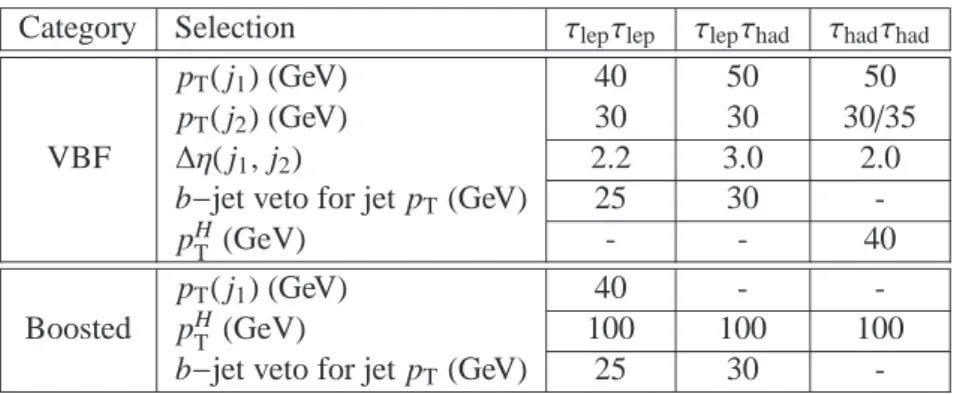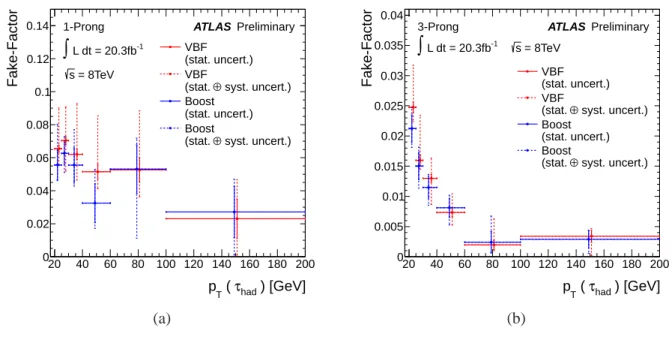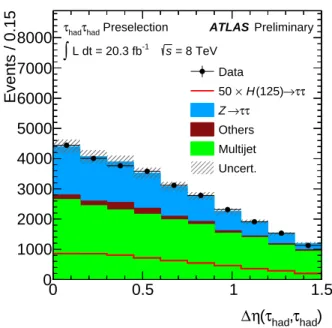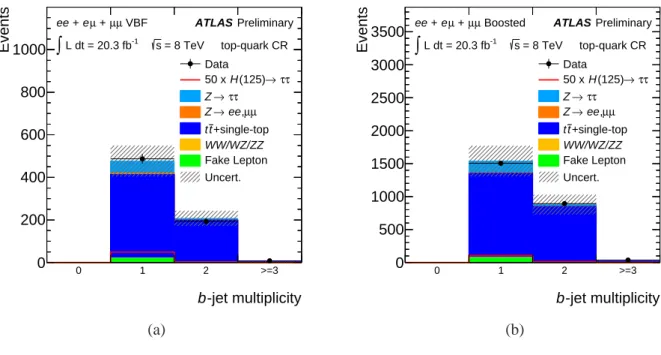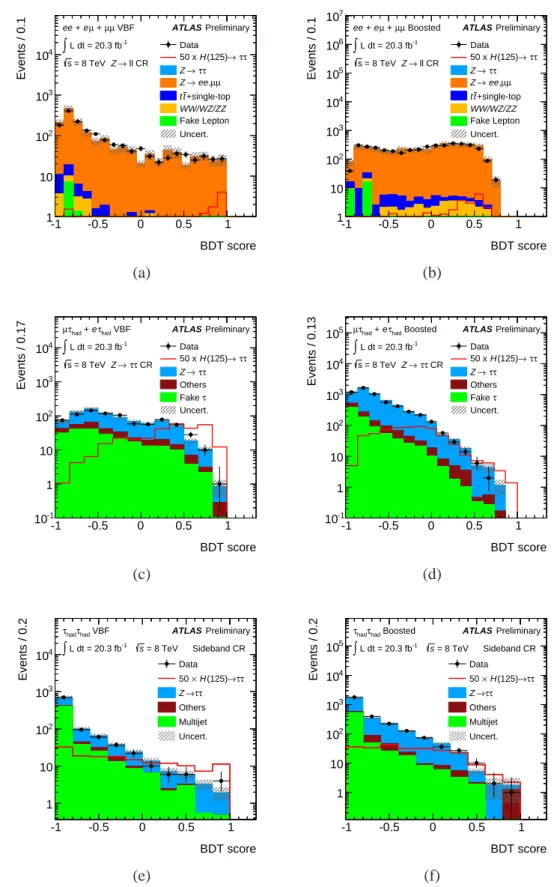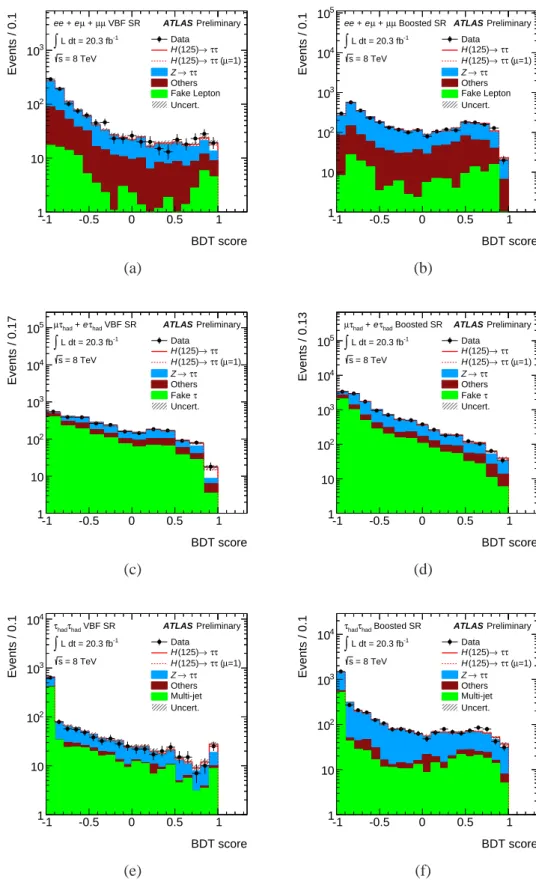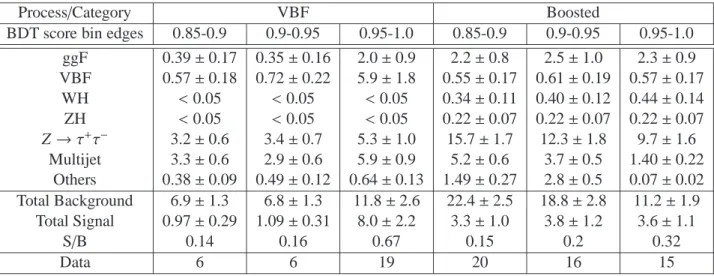ATLAS-CONF-2013-108 28November2013
ATLAS NOTE
ATLAS-CONF-2013-108
November 28, 2013
Evidence for Higgs Boson Decays to the τ
+τ
−Final State with the ATLAS Detector
The ATLAS Collaboration
Abstract
A search for the Higgs boson with a mass of about 125 GeV decaying into a pair of
τleptons is performed with a data sample of proton-proton collisions, corresponding to an integrated luminosity of
L =20.3 fb
−1, collected with the ATLAS detector at the LHC at a centre-of-mass energy of
√s
=8 TeV. Final states in all
τdecay combina- tions (both hadronic and leptonic) are examined. The observed (expected) deviation from the background-only hypothesis corresponds to a significance of 4.1 (3.2) standard devia- tions, and the measured signal strength is
µ=1.4
+0.5−0.4. This is evidence for the existence of H
→τ+τ−decays, consistent with the Standard Model expectation for a Higgs boson with m
H =125 GeV.
c Copyright 2013 CERN for the benefit of the ATLAS Collaboration.
Reproduction of this article or parts of it is allowed as specified in the CC-BY-3.0 license.
1 Introduction
The observation of a new particle with a mass near 125 GeV by the ATLAS and CMS experiments [1, 2]
in the search for the Standard Model (SM) Higgs boson [3–8] is a great success of the Large Hadron Collider (LHC) physics programme at the CERN laboratory. To date, however, evidence for Higgs- boson decays into fermionic final states is not conclusive.
With a branching ratio of 6.3% [9], H
→τ
+τ
−is among the leading decay modes for a SM Higgs boson with a mass of 125 GeV. This decay mode can provide a direct measurement of the coupling of the Higgs boson to fermions, thereby testing an important prediction of the theory. The observation of the H
→τ
+τ
−decay mode would be strong evidence that fermions acquire their mass through the Higgs mechanism.
This note presents a search for the SM Higgs boson in the H
→τ
+lepτ
−lep, H
→τ
+lepτ
−had, and H
→τ
+hadτ
−hadfinal states
1with the ATLAS detector [10], using the full dataset collected in proton-proton (pp) collisions at
√s
=8 TeV in 2012 and corresponding to an integrated luminosity of
L=20.3 fb
−1. The search is designed to be sensitive to the SM Higgs boson produced through gluon fusion (ggF) [11], vector boson fusion (VBF) [12], and associated production (V H) with V
=W or Z de- caying hadronically. All these mechanisms can give rise to jet signatures, particularly in the VBF case, where two high-energy jets with a large pseudorapidity separation are produced.
The results presented in this note supersede those of Ref. [13] which correspond to an analysis of part of the 2012 dataset with a luminosity of
L =13.0 fb
−1, and the full 2011 dataset. The most recent results from the CMS collaboration on the search for the SM Higgs boson in the τ
+τ
−channel can be found in Ref. [14].
2 Analysis Strategy
The ATLAS detector is described in Section 3, with details on the data and simulated samples given in Section 4. Object identification cuts are applied as described in Section 5 and Section 6 details pre- selection cuts for all three channels: τ
lepτ
lep, τ
lepτ
hadand τ
hadτ
had. The events are further classified into categories optimized for the different SM Higgs production mechanisms, as described in Section 7.
The category definitions depend to a certain extent on the channel because of the different background compositions.
Following preselection and categorization, the H
→τ
+τ
−signal is still overwhelmed by a variety of background sources. A boosted decision tree (BDT) multivariate analysis technique is used to discri- minate signal from background [15–17]. Separate BDTs are trained for each channel in each category as described in Section 8, based on input variables that have differing distributions for signal and back- ground. The background estimates are described in Section 9. The BDT output distribution (BDT score) is then used as the final discriminant.
Since a BDT is sensitive to the correlations among variables, it is necessary to demonstrate that these correlations are well modelled. For that reason, the BDT output is computed in several signal-depleted control regions, and the agreement between the data and the background model is confirmed, as described in Section 10.
To ensure that analysis choices are not biased, discriminating variables which might on their own reveal the presence of a signal were blinded throughout the analysis optimization. This blinding was applied to variables such as m
ττand the final BDT score in signal sensitive bins, but not to basic kinematic distributions such as the transverse momentum of τ leptons.
1τlepandτhad denote leptonically and hadronically decayingτleptons, respectively. Charge-conjugate decay modes are implied. Throughout the remainder of this note, a simplified notation without the particle charges is used.
Systematic uncertainties relevant to the analysis are mentioned in Section 11, and the signal extrac- tion procedure is detailed in Section 12. The results of this search are given in Section 13.
3 The ATLAS Detector
The ATLAS detector [10] is a cylindrical
2multi-purpose detector at the LHC. The detector subsystem closest to the interaction point, the Inner Detector (ID), provides precise position and momentum mea- surements of charged particles. It covers the pseudorapidity range
|η
|< 2.5 and provides full azimuthal coverage. It consists of three subdetectors arranged in a coaxial geometry around the beam axis: the silicon pixel detector, the silicon microstrip detector and the straw-tube transition-radiation tracker. A solenoid magnet generates a 2 T magnetic field in which the ID is immersed.
Electromagnetic calorimetry in the region
|η
|< 3.2 is based on a high-granularity, lead/liquid-argon (LAr) sampling technology. Hadronic calorimetry uses a scintillating-tile/steel detector covering the re- gion
|η
|< 1.7 and a copper/LAr detector in the region 1.5 <
|η
|< 3.2. The most forward region of the de- tector 3.1 <
|η
|< 4.9 is equipped with a dedicated forward calorimeter, measuring both electromagnetic and hadronic energies using copper/LAr and tungsten/LAr modules.
A large stand-alone Muon Spectrometer (MS) is the outermost part of the detector. It consists of three large air-core superconducting toroidal magnet systems. The deflection of the muon trajectories in the magnetic field is measured in three layers of precision drift tube chambers for
|η
|< 2. In higher η regions (2.0 <
|η
|< 2.7), two layers of drift tube chambers are used in combination with one layer of cathode strip chambers in the innermost endcap wheels of the MS. Three layers of resistive plate chambers in the barrel (
|η
|< 1.05) and three layers of thin gap chambers in the endcaps (1.05 <
|η
|< 2.4) provide the muon trigger and also measure the muon trajectory in the non-bending plane of the spectrometer magnets.
A three-level trigger system [18] is used to select events in real time. A hardware-based Level-1 trigger uses a subset of detector information to reduce the event rate to a value of at most 75 kHz. The rate of accepted events is then reduced to about 300 Hz by two software-based trigger levels, Level-2 and the Event Filter.
4 Data and Simulated Samples
This search uses pp collision data at
√s
=8 TeV collected in 2012. After requiring that all detector systems are operational, the dataset used corresponds to an integrated luminosity of
L=20.3 fb
−1. The triggers used by each channel are given in Table 1.
The simulated event samples, based on Monte Carlo (MC) techniques and a full description of the the ATLAS detector [19] with GEANT4 [20], are listed below. These samples include the simulation of pile-up activity in the same or nearby bunch crossings. The MC samples are re-weighted to reproduce the observed distribution of the mean number of interactions per bunch crossing in the data.
The simulation of signal events produced via the gluon-fusion and VBF-production mechanisms is performed using the POWHEG [21–23] event generator based on next-to-leading order (NLO) QCD calculations. Soft-gluon resummation up to next-to-next-to-leading logarithm order [24] is adopted. The finite quark-mass effects are taken into account in POWHEG [25]. The parton shower, hadronization and underlying event simulations are provided by PYTHIA [26, 27]. The CT10 [28] parton distribution
2ATLAS uses a right-handed coordinate system with its origin at the nominal interaction point (IP) in the centre of the detector and the z-axis along the beam direction. The x-axis points from the IP to the centre of the LHC ring, and they-axis points upward. Cylindrical coordinates (r, φ) are used in the transverse (x, y) plane,φbeing the azimuthal angle around the beam direction. The pseudorapidity is defined in terms of the polar angleθasη=−ln tan(θ/2). The distance∆R in theη−φ space is defined as∆R=p
(∆η)2+(∆φ)2.
Trigger p
Tthreshold(s) [GeV] τ
lepτ
lepτ
lepτ
hadτ
hadτ
hadElectron 24
• •Muon 24
•Di-electron 12 ; 12
•Di-muon 18 ; 8
•Electron
+Muon 12 ; 8
•Electron
+τ
had18 ; 20
•Muon
+τ
had15 ; 20
•Di-τ
had29 ; 20
•Table 1: Triggers used for each channel. When more than one trigger is used, a logical OR of the triggers is taken and the trigger efficiency is calculated accordingly. The electron+τ
hadand muon+τ
hadtriggers are used for the τ
lepτ
hadchannel at preselection, but not in the VBF and boosted categories as defined in Section 7.
function (PDF) is used. The associated production (V H) samples are generated at leading order (LO) in QCD using PYTHIA with the CTEQ6L1 [29] PDF set. The signal samples are normalized to cross sections computed at next-to-next-to-leading order (NNLO) QCD and taken from Ref. [9].
Background simulation samples use several generators, as described below, each interfaced with HERWIG [30] (with one exception noted below) to provide the parton shower and hadronization.
JIMMY [31] provides the modeling of the underlying event. The samples for W/Z+jets events are generated with ALPGEN [32]. This generator employs the MLM matching scheme [33] between the hard process (calculated with LO matrix elements for up to five jets) and the parton shower. The τ
lepτ
hadchannel uses these samples interfaced with PYTHIA rather than HERWIG. The t¯t samples are pro- duced with MC@NLO [34] with NLO accuracy. Single-top events are generated with AcerMC [35].
The diboson (WW, WZ, ZZ) MC samples are generated using HERWIG for the τ
lepτ
lepchannel. In the τ
hadτ
hadand τ
lepτ
hadchannels, HERWIG is used for the WZ and ZZ samples, while the WW sample is obtained using ALPGEN interfaced to HERWIG. The loop-induced gg
→WW processes are generated using gg2WW [36]. The PDF set used with the AcerMC, ALPGEN and HERWIG event generators is CTEQ6L1, while CT10 is used for the generation of events with MC@NLO and gg2WW.
TAUOLA [37] performs the tau decay and PHOTOS [38] provides additional photon radiation from charged leptons for all samples described. The normalization for these backgrounds is either estimated from data control regions, as described in Section 9, or NLO cross sections are used.
The main and largely irreducible Z/γ
∗→τ
+τ
−background is modelled with selected Z/γ
∗→µ
+µ
−data events, where the muon tracks and associated calorimeter cells are replaced by the corresponding
signatures of the decay of τ leptons. The two τ leptons are simulated by TAUOLA, matched to the
kinematics of the data muons they replace. Here, the τ polarization and spin correlations are modelled
with the TAUOLA program and the µ
−τ mass difference is taken into account. Thus, only the τ decays
(both hadronic and leptonic) and the corresponding detector response are taken from the simulation,
whereas the underlying event kinematics and all other properties, including pile-up effects, are obtained
from the data. This hybrid sample will be referred to as embedded [13] data in the following. The
embedding procedure is extensively validated, e.g. by replacing the muons in selected Z/γ
∗→τ
+τ
−data
events by simulated muons instead of τ leptons. This test is sensitive to systematic effects intrinsic to the
method, for instance due to the subtraction of calorimeter cell energy associated to the data muons. The
validation does not reveal any bias in the embedding procedure [13] beyond the associated systematic
uncertainties.
5 Object and Event Reconstruction
The reconstruction and identification of leptons, jets, and missing transverse momentum are performed using standard ATLAS algorithms briefly described below.
5.1 Electrons
Electron candidates are reconstructed from a cluster in the EM calorimeter and a matching ID track.
They are selected if they pass the Medium [39] identification criteria
3, have transverse energy greater than 15 GeV and are in the region
|η
|< 2.47. Candidates found in the calorimeter transition region (1.37 <
|
η
|< 1.52) are not considered. Typical electron efficiencies, after these selections cuts, range between 80% and 90% depending on η and p
T. Additional isolation criteria, based on tracking and calorimeter information, are used to suppress the background from misidentified jets or from semileptonic decays of charm and bottom hadrons.
5.2 Muons
Muon candidates are reconstructed from the association of an ID-track and an MS-track [40]. The momentum is evaluated from their combination. Muon candidates are selected if they have a transverse momentum greater than 10 GeV and are in the region
|η
|< 2.5. Typical muon efficiencies, after these selection cuts, are approximately 90%. Further isolation criteria are required to suppress the background from misidentified jets or from semileptonic decays of charm and bottom hadrons.
5.3 Jets
Jets are reconstructed by the anti-k
talgorithm [41, 42] with a distance parameter R
=0.4, taking topo- logical clusters [43] in the calorimeters as inputs. The local hadronic calibration scheme [44] and the jet energy scale [44] (JES) are used to calibrate energy deposits from hadrons based on calorimeter signals only. Jets are required to be reconstructed in the range
|η
|< 4.5 and to have a minimum transverse mo- mentum of 30 GeV except in the τ
hadτ
hadchannel where they are required to have a minimum transverse momentum of 35 GeV for
|η
|> 2.4 and in counting b
−tagged jets in the τ
lepτ
lepchannel where the transverse momentum threshold is lowered to 25 GeV.
A jet-vertex fraction (JVF) requirement is used to reduce the number of selected jets in the event due to pile-up activity. The JVF is defined as the ratio between the scalar sum of the transverse momenta of the tracks in the jet associated to the primary vertex and the scalar sum of the transverse momentum of the tracks in the jet associated to any vertex in the event. Jets with
|η
|< 2.4 and p
T< 50 GeV are required to have a JVF exceeding 0.5.
In the pseudorapidity range
|η
|< 2.5, b-jets are selected using a tagging algorithm [45]. The b-tagging algorithm used has an efficiency of 60–70% for b-tagged jets in simulated t¯t events [46].
The corresponding light-quark jet misidentification probability is 0.1–0.5%, depending on the jet p
Tand η [47].
5.4 Hadronically Decaying τ Leptons
Hadronically decaying τ leptons are reconstructed starting from clusters in the electromagnetic and hadronic calorimeters [48]. Tracks in a cone of radius
∆R< 0.2 from the cluster barycentre are as- sociated to the τ
hadcandidate, and the τ
hadcharge is determined from the sum of track charges. This search uses τ
hadcandidates with p
T> 20 GeV and
|η
|< 2.47. The τ
hadcandidates are required to
3The electron identification criteria have been reoptimized for 2012 data-taking conditions.
have charge
±1, and must be 1- or 3-track (prong) candidates. The two-track sample (where the charge requirement is dropped) is retained for background studies as described in Section 9.1. A BDT τ identi- fication method is used, requiring that the τ
hadcandidate passes the Medium [49] identification criteria, corresponding to approximately 55–60% efficiency. Dedicated criteria [49] to suppress τ
hadcandidates from misidentified electrons and muons are also applied. The misidentification probabilities for τ
hadcandidates with p
T> 20 GeV have a typical value of 1–2% .
5.5 Object Overlap Removal
When different objects selected according to the criteria mentioned above overlap with each other geo- metrically (within
∆R< 0.2), only one of them is considered. The overlap is resolved by selecting muon, electron, τ
hadand jet candidates in this order of priority.
5.6 Missing Transverse Momentum
The signal events are characterized by true missing transverse momentum (E
missT) due to the presence of the neutrinos from τ decays. In this analysis, the E
missTreconstruction [50] uses calorimeter cells calibrated according to the reconstructed physics objects to which they are associated. Calorimeter cells are associated with a reconstructed and identified high- p
Tparent object in the following order: electrons, photons, hadronically decaying τ-leptons, jets and muons. Calorimeter cells not associated with any other objects are scaled by the soft term vertex fraction and are used in the E
missTcalculation. This fraction is the ratio of the scalar sum of the p
Tof tracks from the primary vertex unmatched to objects to the scalar sum p
Tof all tracks in the event also unmatched to objects. This method allows a better reconstruction of the E
Tmissin high pile-up conditions [51]. The p
Tof muons identified in the events are also taken into account in the E
Tmisscalculation.
In the τ
lepτ
lepchannel, a second variable named High p
TObjects E
Tmiss(HPTO E
Tmiss) is also used to reject Drell-Yan background. It is built from the high p
Tobjects: the two leptons and the jets with p
T> 25 GeV. The two E
Tmissvariables are strongly correlated for the signal due to neutrinos in the final state, but only loosely correlated for background from Z
→e
+e
−and Z
→µ
+µ
−.
5.7 Higgs Candidate Kinematic Reconstruction
The invariant ττ mass (m
MMCττ) is reconstructed using the missing mass calculator (MMC) [52]. This requires solving an underconstrained system of equations for 6 to 8 unknowns, depending on the number of neutrinos in the τ
+τ
−final state. These unknowns include the x-, y-, and z-components of the momen- tum carried by the undetected neutrinos for each of the two τ leptons in the event, and the invariant mass of the two neutrinos from any leptonic τ decays. This is done by using the constraints from the measured x and y components of E
missT, and the visible masses of both τ candidates. A scan is then performed over the yet undetermined variables, and each scan point is then weighted by its probability according to the τ decay topologies. The estimator for the ττ mass (m
MMCττ) is then defined as the most probable value of the weighted scan points.
Another important variable is the transverse momentum p
THof the Higgs-boson candidate. This quantity is reconstructed using the vector sum of the event E
missTand the transverse momentum of the visible τ decay products.
6 Preselection
In addition to criteria to ensure the detector was functioning properly, requirements are applied in order
to increase the purity and quality of the data sample by rejecting non-collision events such as cosmic rays
and beam halo events. To ensure that the event is the result of hard-scattering, at least one vertex with at least four associated tracks and a position consistent with the beam spot position is required. After these basic criteria are applied, the event preselection varies by channel.
For all channels, the leptons that are considered for overlap removal with τ
hadcandidates need only satisfy Loose criteria, to reduce misidentified τ
hadcandidates from leptons. The p
Tthreshold of muons considered for overlap removal is also lowered to 4 GeV.
The channels involving real electrons and muons, τ
lepτ
lepand τ
lepτ
had, use tighter selections of electron and muon candidates, including isolation criteria. For the τ
hadcandidates considered in the τ
lepτ
lepand τ
lepτ
hadchannels, the criteria used to reject electrons misidentified as τ
hadcandidates are tightened [49].
Higher p
Tthresholds are applied to electrons, muons, and τ
hadcandidates according to the trigger condition satisfied by the event, as described in Table 1. For events passing the single-electron or single- muon trigger, an offline requirement of p
T> 26 GeV is applied for the lepton that triggered the event.
The p
Tthresholds are unchanged from the general object selection for events passing the di-electron and electron+muon combined triggers. For events passing the di-muon trigger, the leading muon is required to have p
T> 20 GeV. For the combined electron+τ
hadand muon+τ
hadtriggers, the τ
hadcandidates must satisfy p
T> 25 GeV, while the electron and muon candidates must have transverse momenta exceeding 20 and 17 GeV, respectively. In the τ
hadτ
hadchannel, where the events are required to pass the di
−τ
hadtrigger, the leading (sub-leading) τ
hadcandidate must satisfy p
T> 35(25) GeV.
6.1 The τ
lepτ
lepChannel
In the τ
lepτ
lepchannel, exactly two isolated leptons of opposite-sign (OS) charges are required. Events containing a τ
hadcandidate are vetoed. The two leptons must satisfy 30 < m
visττ< 100 GeV in the e
+µ
−channel, and 30 < m
visττ< 75 GeV for the e
+e
−and µ
+µ
−channels
4, thus avoiding Z, charmonium and bottomonium resonances. It is also required that the scalar sum of the transverse momenta p
T(ℓ
1)+ p
T(ℓ
2) exceeds 35 GeV and that
∆φℓℓ< 2.5.
For e
+e
−and µ
+µ
−final states, the E
missTand HPTO E
missTmust both be greater than 40 GeV, while for e
+µ
−only a requirement of E
missT> 20 GeV is made.
Finally, the fraction of the momentum of each tau lepton carried by its visible decay products
5(cal- culated using the collinear approximation to determine the neutrino momenta [53]), as defined by the equation,
x
τ1(2)=p
vis1(2)p
vis1(2)+p
mis1(2)(1)
are required to satisfy 0.1 < x
τ1, x
τ2< 1.
6.2 The τ
lepτ
hadChannel
In the τ
lepτ
hadchannel, exactly one lepton and one τ
hadcandidate with OS charges, passing the given p
Tthresholds, are required. To substantially reduce the W
+jets background at this stage, events are rejectedif the transverse mass
6constructed from the lepton and the E
Tmisssatisfies m
T> 70 GeV.
4mvisττ is defined as the invariant mass of the visible decay products of theτleptons.
5pvisis defined as the total momentum of the visible decay products of theτlepton. pmisis defined as the momentum of the neutrino reconstructed using the collinear approximation.
6mT = q
2pT(ℓ)×ETmiss×(1−cos∆φ), and∆φis the azimuthal separation between the directions of the lepton and the missing transverse momentum vector.
6.3 The τ
hadτ
hadChannel
In the τ
hadτ
hadchannel, exactly two τ
hadcandidates with OS charges are required. Events with electron or muon candidates are rejected. Trigger requirements in this channel motivate minimum p
Tthresholds of p
T(τ
had1) > 35 GeV and p
T(τ
had2) > 25 GeV, as mentioned at the beginning of Section 6.
In order to reduce the background from multijet production and to exclude badly modelled events, several additional requirements are applied: the τ
hadidentification criteria are tightened such that at least one of the candidates satisfies the Tight criteria, and the separation between the two τ
hadcandidates must satisfy 0.8 <
∆R(τhad, τ
had) < 2.8 and
∆η(τhad, τ
had) < 1.5. The missing transverse momentum requirement is set to E
missT> 20 GeV and the E
missTdirection must either be between the two visible τ
hadcandidates in φ or the condition min[∆φ(τ, E
Tmiss)] < π/2 must be fulfilled.
6.4 Kinematic Distributions after Preselection
In Figures 1-3, the distributions for E
Tmiss, m
visττ, p
HT, and
∆η( j1, j
2) (for events with at least two jets) are shown for each channel after the preselection criteria have been applied. Good agreement is shown between the observed data and the predictions from the background modelling, which is discussed in Section 9. The variables E
Tmissand m
visττare important kinematic variables that are correlated with m
MMCττ, while p
HTand
∆η( j1, j
2) are variables that help define the categorization of events as described in Sec- tion 7.
7 Analysis Categories
In order to exploit signal-sensitive event topologies, two analysis categories are defined in an exclusive way:
•
VBF: targeted at the vector boson fusion Higgs production mechanism. This category is characte- rized by the presence of two jets with a large pseudorapidity separation. Some signal events from the gluon-fusion and V H production mechanisms are also selected in this category.
•
Boosted: targeted at events with a boosted Higgs boson from the gluon-fusion production mecha- nism. It includes only events which fail the VBF category definition. Hence, this category selects Higgs boson candidates which have larger p
T(p
TH> 100 GeV) and well-measured mass. Some signal events from the VBF and V H production mechanisms are also selected in this category.
While these categories are conceptually identical across the three channels, differences in dominant backgrounds and in dataset size require that the selection criteria differ in each. Table 2 specifies the selection criteria used for each channel. For both categories, the requirement on jets is an inclusive requirement: additional jets aside from those passing the category requirements are not discriminated against. The
∆η( j1, j
2) requirement is applied using the highest two p
Tjets in the event. A b-jet veto is used in the τ
lepτ
lepand τ
lepτ
hadchannels to suppress top-quark backgrounds. The τ
lepτ
hadchannel imposes an additional cut on events in the VBF category, requiring that m
visττ> 40 GeV. The events failing this cut are not used in the boosted category. Furthermore, while other triggers were included at preselection, the final τ
lepτ
hadcategories only consider events accepted by the single electron or single muon trigger.
8 Boosted Decision Trees
BDTs are used in each category to extract the Higgs-boson signal from the large number of background
events. Decision trees [15] recursively partition the parameter space into multiple regions where signal
[GeV]
miss
ET
0 50 100 150
Events / 10 GeV
0 500 1000 1500 2000 2500 3000 3500 4000 4500
Data
τ τ
→ (125) H 50 x
τ τ
→ Z
µ µ ,
→ee Z
+single-top t
t
WW/WZ/ZZ Fake Lepton Uncert.
Preselection µ
µ µ + e +
ee ATLAS Preliminary
= 8 TeV
-1 s L dt = 20.3 fb
∫
[GeV]
visτ
mτ
40 60 80 100
Events / 5 GeV
0 500 1000 1500 2000 2500 3000 3500
Data
τ τ
→ (125) H 50 x
τ τ
→ Z
µ µ ,
→ee Z
+single-top t
t
WW/WZ/ZZ Fake Lepton Uncert.
Preselection µ
µ µ + e +
ee ATLAS Preliminary
= 8 TeV
-1 s L dt = 20.3 fb
∫
(a) (b)
[GeV]
H
pT
0 100 200 300
Events / 20 GeV
10 102
103
104
105
106
Data
τ τ
→ (125) H 50 x
τ τ
→ Z
µ µ ,
→ee Z
+single-top t
t
WW/WZ/ZZ Fake Lepton Uncert.
Preselection µ
µ µ + e +
ee ATLAS Preliminary
= 8 TeV s
L dt = 20.3 fb-1
∫
2)
1j, j η(
∆
0 2 4 6
Events / 0.5
0 500 1000 1500 2000 2500 3000
Data
τ τ
→ (125) H 50 x
τ τ
→ Z
µ µ ,
→ee Z
+single-top t
t
WW/WZ/ZZ Fake Lepton Uncert.
Preselection µ
µ µ + e +
ee ATLAS Preliminary
= 8 TeV
-1 s L dt = 20.3 fb
∫
(c) (d)
Figure 1: Kinematic distributions for the τ
lepτ
lepchannel after preselection: (a) E
missT, (b) m
visττ, (c) p
TH,
and (d)
∆η( j1, j
2). The background estimate for these distributions is described in Section 9. The m
visττdistribution shows a step at 75 GeV due to the difference in cuts between same flavour and different
flavour event selection. The
∆η( j1, j
2) distribution is shown for events with at least two jets. Signal
shapes are shown multiplied by a factor of 50. These figures use background predictions made without
the global fit defined in Section 12.
[GeV]
miss
ET
0 50 100
Events / 10 GeV
0 20 40 60 80 100 120 140 160 180 200 220
103
×
Data
τ τ
→ (125) H 50 x
τ τ
→ Z Others
τ Fake Uncert.
Preselection τhad
e
had + τ
µ ATLAS Preliminary
= 8 TeV
-1 s L dt = 20.3 fb
∫
[GeV]
visτ
mτ
0 100 200
Events / 10 GeV
0 20 40 60 80 100 120 140 160 180
103
×
Data
τ τ
→ (125) H 50 x
τ τ
→ Z Others
τ Fake Uncert.
Preselection τhad
e
had + τ
µ ATLAS Preliminary
= 8 TeV
-1 s L dt = 20.3 fb
∫
(a) (b)
[GeV]
H
pT
0 100 200 300
Events / 15 GeV
102
103
104
105
106
107
108
Data
τ τ
→ (125) H 50 x
τ τ
→ Z Others
τ Fake Uncert.
Preselection τhad
e
had + τ
µ ATLAS Preliminary
= 8 TeV s
L dt = 20.3 fb-1
∫
2)
1j, j η(
∆
0 2 4 6
Events / 0.5
0 2 4 6 8 10 12 14 16 18 20
103
×
Data
τ τ
→ (125) H 50 x
τ τ
→ Z Others
τ Fake Uncert.
Preselection τhad
e
had + τ
µ ATLAS Preliminary
= 8 TeV
-1 s L dt = 20.3 fb
∫
(c) (d)
Figure 2: Kinematic distributions for the τ
lepτ
hadchannel after preselection: (a) E
missT, (b) m
visττ, (c) p
HT, and (d)
∆η( j1, j
2). The background estimate for these distributions is described in Section 9. The
∆η( j1
, j
2) distribution is shown for events with at least two jets. Signal shapes are shown multiplied by a
factor of 50. These figures use background predictions made without the global fit defined in Section 12.
[GeV]
T
Emiss
20 30 40 50 60 70
Events / 5 GeV
0 2 4 6 8 10 12 14
103
×
Data
τ τ
→ (125)
×H 50
τ τ
→ Z Others Multijet Uncert.
Preselection τhad
τhad
= 8 TeV s
-1 L dt = 20.3 fb
∫
ATLAS Preliminary
[GeV]
τ τvis
m 40 60 80 100 120 140
Events / 6 GeV
0 1000 2000 3000 4000 5000 6000 7000 8000
Data
τ τ
→ (125)
×H 50
τ τ
→ Z Others Multijet Uncert.
Preselection τhad
τhad
= 8 TeV s
-1 L dt = 20.3 fb
∫
ATLAS Preliminary
(a) (b)
[GeV]
H
pT
0 50 100 150 200
Events / 10 GeV
102
103
104
105
106
Data
τ τ
→ (125)
×H 50
τ τ
→ Z Others Multijet Uncert.
Preselection τhad
τhad
= 8 TeV s
-1 L dt = 20.3 fb
∫
ATLAS Preliminary
2)
1j, j η(
∆
0 2 4 6
Events / 0.5
0 200 400 600 800 1000 1200 1400 1600
Data
τ τ
→ (125)
×H 50
τ τ
→ Z Others Multijet Uncert.
Preselection τhad
τhad
= 8 TeV s
-1 L dt = 20.3 fb
∫
ATLAS Preliminary
(c) (d)
Figure 3: Kinematic distributions for the τ
hadτ
hadchannel after preselection: (a) E
missT, (b) m
visττ, (c) p
HT, and (d)
∆η( j1, j
2). The background estimate for these distributions is described in Section 9. The
∆η( j1
, j
2) distribution is shown for events with at least two jets. Signal shapes are shown multiplied by a
factor of 50. These figures use background predictions made without the global fit defined in Section 12.
Category Selection τ
lepτ
lepτ
lepτ
hadτ
hadτ
hadVBF
p
T( j
1) (GeV) 40 50 50
p
T( j
2) (GeV) 30 30 30/35
∆η( j1
, j
2) 2.2 3.0 2.0
b
−jet veto for jet p
T(GeV) 25 30 -
p
HT(GeV) - - 40
Boosted
p
T( j
1) (GeV) 40 - -
p
HT(GeV) 100 100 100
b
−jet veto for jet p
T(GeV) 25 30 -
Table 2: Selection criteria applied in each analysis category for each channel. The numbers shown are lower thresholds. Only events that fail VBF category selection are considered for the boosted category.
The
∆η( j1, j
2) cut is applied on the two highest p
Tjets in the event. Events in the τ
lepτ
hadVBF category must also satisfy m
visττ> 40 GeV, and those that fail this requirement are not considered for the τ
lepτ
hadboosted category. The p
T( j
2) threshold in the τ
hadτ
hadchannel is 30 (35) GeV for jets within (outside of)
|η
|=2.4.
or background purities have been enhanced. Boosting is a method which improves the performance and stability of decision trees and involves the combination of many trees into a single final discriminant [16, 17]. After boosting, the final score undergoes a monotonic transformation to spread the scores between -1 and 1. The most signal-like events have scores near 1 while the most background-like have scores near -1.
BDTs trained on a sample of signal and background must be evaluated on an independent sample of events. In this analysis each sample (signal and background) is partitioned into two separate samples A and B, each with separate associated BDTs. The training is then performed with sample A and evaluated on sample B and vice-versa. For events in data, they are evaluated in the same way, such that half use the BDT trained on sample A and half use the BDT trained on sample B. For background model or signal MC events, the final distributions use all sample A events (evaluated using the BDT trained on sample B) and all sample B events (evaluated using BDT trained on sample A). In this way, 100% of each of the original samples appears in the final distributions, but no BDT is ever applied on an event from its own training sample.
Separate BDTs are trained for each analysis category and channel. Separately training by category naturally exploits differences in event kinematics between different Higgs boson production modes. The VBF category is trained with only a VBF signal sample, while the Boosted category is trained with gluon-gluon fusion, VBF, and V H signal samples. The signal samples used for all production processes in the training have m
H =125 GeV. Separately training in each channel allows different discriminating variables to be used to address the differing background compositions in each channel. The details of background models and compositions for each channel are described in Section 9. The BDT input variables for each category are shown in Table 3. Most of these variables have straightforward definitions;
those requiring definition are listed below:
•
p
TotalT: Magnitude of vector sum of the visible components of the τ decay products, the two leading jets and the E
missT.
•
sum p
T: Scalar sum of p
Tof the visible components of the τ decay products and of the jets.
•
E
missTφ centrality: A variable that quantifies the relative angular position of the E
Tmisswith respect
to the τ decay products in the transverse plane. The transverse plane is transformed such that the
direction of the τ decay products are orthogonal, and that the smaller φ angle between the τ decay products defines the positive quadrant of the transformed plane. E
Tmissφ centrality is defined as the sum of the x and y components of the E
missTunit vector in this transformed plane.
•
sphericity: A variable that describes the isotropy of energy flow. It is based on the quadratic momentum tensor:
S
αβ = Pi
p
αip
βi Pi|
p ~
i2|. (2)
Both leptons and the selected jets are considered in the computation. In this equation, α and β are the indices of the tensor, and the summation is performed over the momenta of the leptons and the jets in the event. The sphericity of the event is then defined in terms of the two largest eigenvalues of this tensor, λ
2and λ
3:
S
=3
2 (λ
2+λ
3). (3)
•
object η centrality: A variable that quantifies the η position of an object (a τ
hadcandidate or an isolated lepton) with respect to the two leading jets in the event. It is defined as
C
η1,η2(η)
=exp
"
−
4 (η
1−η
2)
2
η
−η
1+η
22
2#
(4) where η
1and η
2are the pseudorapidities of the two leading jets. This variable has value 1 when the object is halfway between the two jets, 1/e when the object is aligned with one of the jets, and
< 1/e when the object is outside the jets. This variable is used for the following BDT inputs: ℓ
1×ℓ
2η centrality (product of the two η centralities), ℓ η centrality, j
3η centrality and τ
1,2η centrality (η centrality of each τ
had). When j
3η centrality is used, events with only two jets are assigned a dummy value of
−0.5.
9 Background Estimation
The background models are derived from a mixture of simulated samples and data. The normalization of background contributions generally relies on comparing the simulated samples of individual backgrounds to data in regions which have little signal contamination. The differences in background composition of the three channels necessitates different strategies for the background estimation. Common to all three is the dominant Z
→τ
+τ
−background which is taken from τ-embedded Z
→µ
+µ
−data, described in Section 4.
In the τ
lepτ
lepchannel, a non-isolated lepton region is used to model multijet, W
+jets, and semi-leptonic t¯t backgrounds, while other contributions are estimated using simulated samples.
The τ
lepτ
hadchannel measures misidentification factors (called “fake-factors”, described below) for evaluating contributions from multijet and W+jets backgrounds where a jet can be misidentified as a τ
hadcandidate. Other remaining backgrounds are accounted for using MC simulation normalized in control regions.
The τ
hadτ
hadchannel strategy is to model the multijet background with so-called not-opposite-sign (notOS) data, with τ
hadcandidates being required not to have opposite charges, and then to normalize the multijet and Z
→τ
+τ
−samples simultaneously as described in Section 9.1. All other backgrounds and their normalizations are taken from MC simulation.
The treatment of each background contribution is now described, highlighting differences among the
three channels.
Variable VBF Boosted
τ
lepτ
lepτ
lepτ
hadτ
hadτ
hadτ
lepτ
lepτ
lepτ
hadτ
hadτ
hadm
MMCττ • • • • • •∆R(τ, τ) • • • • •
∆η( j1
, j
2)
• • •m
j1,j2 • • •η
j1×η
j2 • •p
TotalT • •sum p
T • •p
T(τ
1)/p
T(τ
2)
• •E
missTφ centrality
• • • • •x
τ1and x
τ2 •m
ττ,j1 •m
ℓ1,ℓ2 •∆φℓ1,ℓ2 •
sphericity
•p
ℓT1 •p
Tj1 •E
missT/p
ℓT2 •m
T • •min(∆η
ℓ1ℓ2,jets)
•j
3η centrality
•ℓ
1×ℓ
2η centrality
•ℓ η centrality
•τ
1,2η centrality
•Table 3: Discriminating variables used for each channel and category. The filled circles identify which
variables are used in each decay mode. Note that variables such as
∆R(τ, τ) are defined either betweenthe two leptons, between the lepton and τ
had, or between the two τ
hadcandidates, depending on the decay
mode.
9.1 Data-Driven Backgrounds
The τ
lepτ
lepchannel treats all backgrounds from a misidentified lepton together, which accounts for mul- tijet, W+jets and semileptonic t¯t processes. A control sample is created for this purpose by inverting isolation selections on one of the two leptons and subtracting contributions from other electroweak back- grounds (dileptonic t¯t , Z
→e
+e
−, Z
→µ
+µ
−, Z
→τ
lepτ
lep, diboson) obtained from MC simulations.
A template is created from this sample and normalized by fitting the p
Tdistribution of the sub-leading lepton at an early stage in the preselection requirements defined in Section 6.1.
The τ
lepτ
hadchannel uses the “fake-factor” [13] method to derive estimates for multijet and W
+jetsbackgrounds that pass the τ
lepτ
hadselection due to a misidentified τ
hadcandidate. The fake-factor method requires a sample enriched in fake τ
hadcandidates defined by applying an event selection equivalent to the VBF and boosted category definitions except that the candidate must fail the Medium [49] τ
hadidentification requirement. The fake-factor is defined by the ratio of identified τ
hadcandidates to non- identified τ
hadcandidates. This is determined separately for samples dominated by quark and gluon jets using a separate W
+jets control region which is dominated by quark jets defined by high mTand a loose lepton region dominated by gluon jets. The derived fake-factors, weighted by the expected relative W+jets/multijets composition, also determined in the same control regions, are then applied to the fake τ
hadevents to calculate the expected multijet and W+jets background. The p
T(τ
had) dependence of these fake-factors is shown in Figure 4.
) [GeV]
τhad T ( p
20 40 60 80 100 120 140 160 180 200
Fake-Factor
0 0.02 0.04 0.06 0.08 0.1 0.12 0.14
VBF (stat. uncert.) VBF
syst. uncert.)
⊕ (stat.
Boost (stat. uncert.) Boost
syst. uncert.)
⊕ (stat.
ATLAS Preliminary 1-Prong
∫
L dt = 20.3fb-1 = 8TeV s) [GeV]
τhad T ( p
20 40 60 80 100 120 140 160 180 200
Fake-Factor
0 0.005 0.01 0.015 0.02 0.025 0.03 0.035 0.04
VBF (stat. uncert.) VBF
syst. uncert.)
⊕ (stat.
Boost (stat. uncert.) Boost
syst. uncert.)
⊕ (stat.
ATLAS Preliminary
∫
3-Prong
= 8TeV s
-1 L dt = 20.3fb


